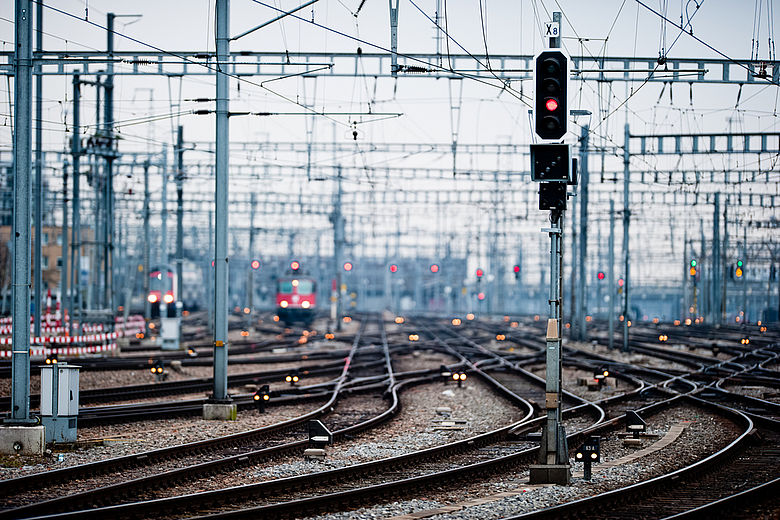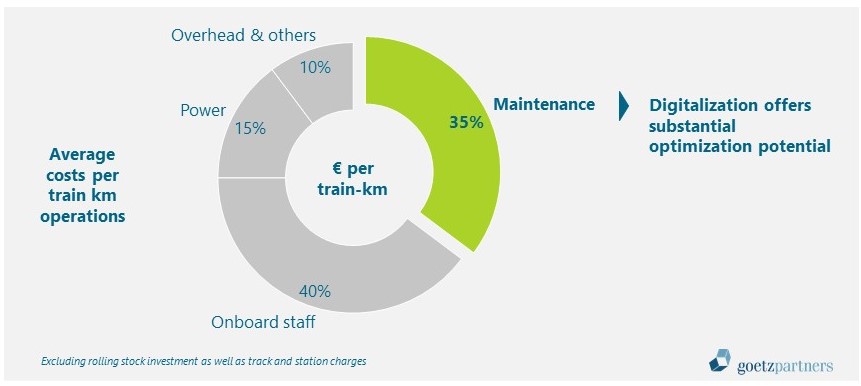Article
Challenges and opportunites facing the operational digitization of rail


Operational digitization of the rail system offers substantial potential to increase efficiency and re-
silience – this is common sense. Yet, although rail players across the value chain are ramping up their capabilities, there is often a substantial gap between aspiration levels and operational reality.
Implementing digital solutions P&L-effectively remains a challenge for the industry. Typical hurdles on the way include, e.g., focusing on real operational problems, managing the intra-organizational clash of cultures, or implementing technology into (new) processes. To overcome such hurdles, goetzpartners has developed a programmatic operational digitization approach that aims to implement concrete operational digital lighthouse use-cases. The key is to solve today's problems while also re-configurating overarching organizational, operational, and technological structures. Evolution while triggering revolution!
Operational digitization to solve the rail puzzle?!
AI, the Internet of Things (IoT), digital twins, predictive maintenance – many (buzz-)words are currently circulating in the digitalization of the rail industry. While overstretched from time to time, beyond the buzz, the digital interconnectivity of different elements in the rail network will be the lever for optimizing availability, quality, and efficiency – and hence for reducing total cost per operated train kilometer as well as improving quality.
For example, consider maintenance efforts: Most maintenance schemes and underlying processes today are based on (practical) experience, historical observations, and respective FPMH/ FPMK assumptions. Additionally, these assumptions typically factor in additional security buffers. This predominantly analog and manual experience-based approach results in inflexible and reactive maintenance systems.
While these pitfalls and the respective potential are not big news, they are, nevertheless, more relevant than ever: 80% of surveyed rail industry representatives at the International Railway Summit 2021 see additional potential from digital integration for system availability and cost of maintenance as key to the future of the industry. Rail-related players along the value chain have strategically ramped up their capabilities or expanded their competence via targeted acquisitions in recent years. Industry cooperation is increasing, with partnerships in very concrete digital use-cases or rather broad strategic alliances – the race seems to be heating up.
Beyond the vision: Operational digitization remains challenging
However, behind the buzz, implementing digital solutions operationally and P&L-effectively remains a challenge for rail industry players: digitizing the oldest start-up in the world by complementing "heavy metal" with "AI" (not the other way around) in a brownfield environment with stringent security standards is complex. The main challenge and prerequisite for realizing digitization potential is the seamless integration of various building blocks with technology (soft- and hardware on track and train, data logics, analytics, etc.), processes, operations, and organizations.
Typical challenges that we observe in operational digitization projects include the following:
- Gaining a real understanding of the operational/technological problem to be solved:
Digital because of digital: without a concrete operational problem to solve, digital use cases lack focus and, hence, orientation. Ultimately, operational benefits cannot be realized.
- Unclear and complex data:
Data is the blood running through the veins of digital solutions. "Sick" data lacking quality, transparency, and uniform data types cannot solve operational problems.
a) Clash of cultures within the organization:
Data scientists vs. engineers vs. maintenance workers: Solutions developed without end-users lack granularity, quality, and adoption: There is no artificial intelligence without human relevance.
b) Balancing speed and breadth with accuracy and depth:
Building a fancy-looking dashboard is a fairly quick job. But developing operationally helpful solutions requires in-depth physical-technical understanding, especially in the safety-critical rail environment. However, it is crucial to follow a pragmatic approach with the right balance of speed and detail appropriate to the project.
c) Technology parallel to existing operational processes:
Using technology is no self-fulfilling prophecy: A lose-lose situation is created without operational integration into existing processes.
The overarching mission for rail companies remains to successfully bridge the gap between strategic ambition and operational go-live, realizing evolution and revolution in parallel!
A programmatic operational digitization approach to overcome today's challenges
To meet this antagonistic aspiration, a programmatic, operational digitization approach could pave the way for rail players. Such a programmatic approach aims to implement concrete operational digital lighthouse use-cases that solve today's problems (the evolution), while also re-configuring overarching organizational, operational, and technological structures (the revolution).
By building digital lighthouse use-cases – and, hence, solutions for concrete operational problems with a direct P&L effect – blueprints for such operational digitization projects are established "at the living object." These follow a rigorous realization approach, developing a "Minimum Viable Product" (MVP) in quick iterations – technically as well as organizationally. Such a prototype is then piloted and tested in the operational environment. After a successful MVP-phase, the solution should be refined, go-live, and scaled, respectively.
While this rather evolutionary approach to rail digitization (and discovery in general) may solve (only) one problem at a time, it creates a strong pull effect when executed correctly. Making digital solutions work operationally may be the most vital trigger for change. Hence, such a lighthouse use-case is more than "a project" – it is the catalyst for organization-wide transformation (the revolution). This not only includes digitizing respective processes and operational structures, but also further developing technical architectures and systems to the degree required for scaling.
Clearly, programmatic operational digitization is a multifaceted challenge. Understanding technical-engineering correlations, consolidating and integrating business requirements, orchestrating organization-wide collaboration, overcoming potential skeptics and silos and driving progress and change: a demanding and often tedious task requiring additional in-depth engineering/technical expertise and project management professionals beyond data competence. Such an integrated set-up has proven to be an accelerator for operational digitalization in rail.
Author:
Dr. Christian Wältermann, Head of Mobility & Infrastructure (Email)
